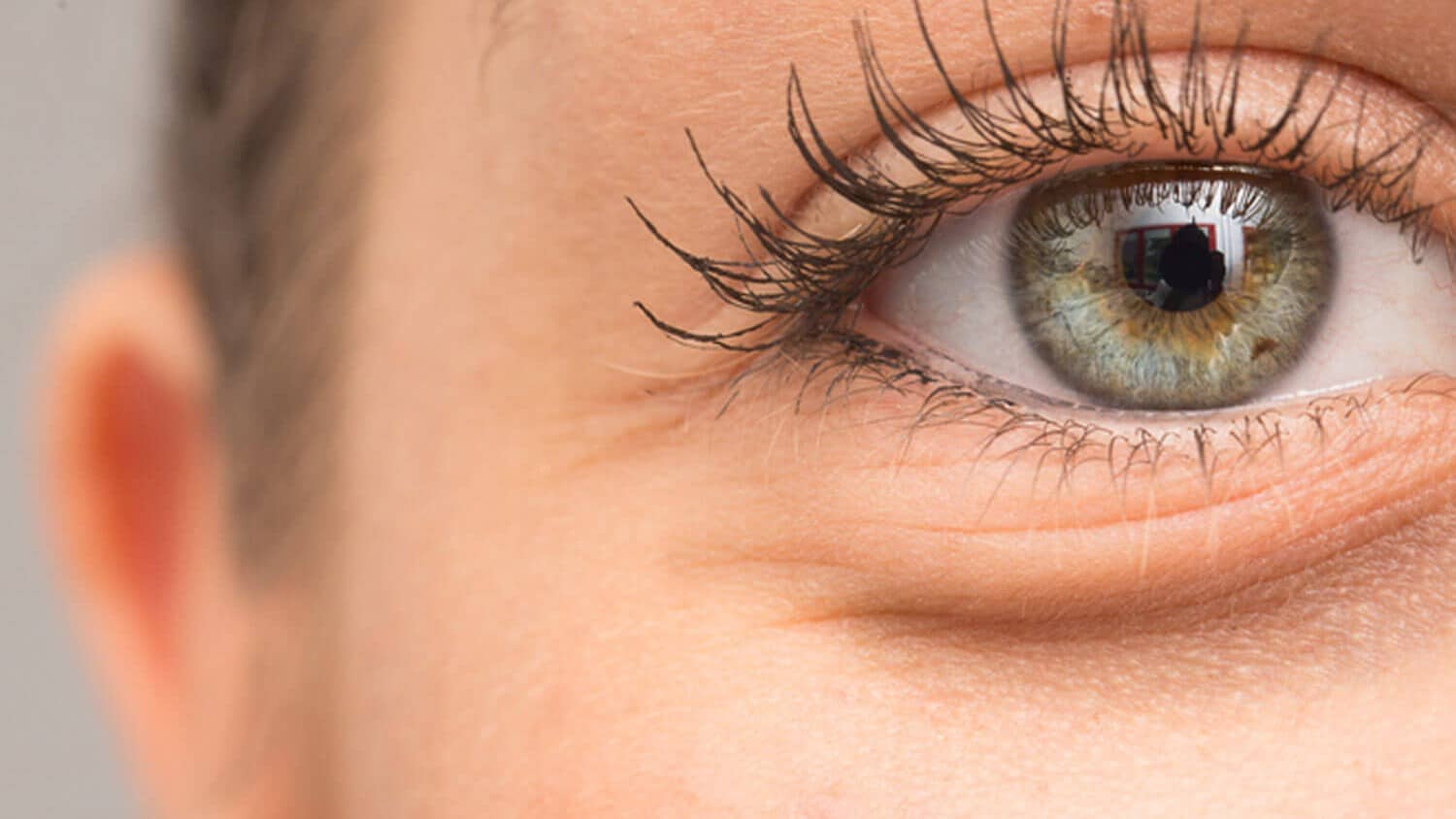Dr. Karen Leong | 04/15/2020
Under eye bags and under eye hollows plague many of us. You may have had these since you were young, or you come from a family where generations have passed along this trait. You notice that the bags are puffier or darker in the mornings, if you’re over tired or stressed or if you’ve had more salt or alcohol in your diet than usual. You’ve tried eye creams and icing and masks, whatever you can find but the problem keeps getting worse!
Under eye bags and under eye hollows are anatomically driven and multifactorial. You may have either or both. Let’s look at them one by one.
Under Eye Bags:
I typically explain during consultation that these are caused by a combination of things. First of all, the skin around the eyes is the thinnest and most delicate skin on your entire body. That means that it is easily affected by swelling and venous stasis (blood pooling that gives the dark purplish discoloration). The skin is more prone to sun damage that leads to crepiness and dryness. The muscle around the eye is very active as well – the orbicularis oculi muscle allows us to blink and squint; repeated motions lead to wrinkles and creases like crows feet. As the muscle weakens over time, fat begins to bulge through resulting in bags under the eyes. If you look at the anatomy of the lower eyelid, there are 3 pockets of fat that sit above the bony rim of the orbit. These are the medial, middle, and lateral fat pads and they each contribute to the lower eye bag. The reason the bags look as prominent and bulge as much as they can is because the lower eyelid transitions into the cheek at that bony rim. It is typically tethered there by a fascial attachment called the arcus marginalis. So you have bulging fat and weakened muscles above and a strong attachment below. This constellation results in puffy lower lids. In some people, the constant cycling of swelling and deflating over time damages the skin and supporting structures and eventually leads to festoons.
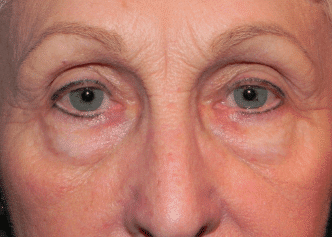
Lower Eyelid Bags
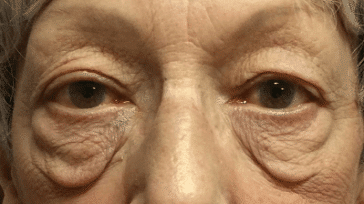
Festoons
Under Eye Hollows:
Typically referred to as tear trough deformity, the under eye hollow is again an anatomic finding that occurs as we age. The same lower eyelid to cheek transition at the bony orbit that differentiates the lower eyelid from the cheek is responsible for the tear trough deformity. Below the bony rim then forms a depression we call the nasojugal fold. It becomes noticeable over time as the “apple” of the cheek (malar mound) deflates and falls. The tear trough deformity can also extend laterally to include the outer portion of the lower lid and manifests as the palpebromalar groove.
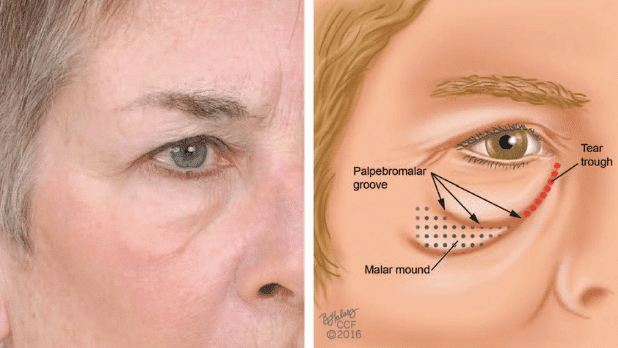

Treatment Options:
1. Mild under eye bags and mild tear trough deformity can be corrected nonsurgically with hyaluronic acid fillers to mask the puffiness and fill in the hollow. In my practice, I am particularly fond of using Restylane Refyne for these patients although every individual is different and your plan is customized to your needs.The results can last up to 4-5 years although most will come in for a touch up every 18-24 months because we don’t stop aging!
2. Moderate under eye bags are best treated surgically. Most of my patients are candidates for transconjunctival blepharoplasty, which you may see referred to as “scarless lower eyelid surgery”. An incision is made on the inner surface of the lower eyelid that gives direct access to the fat pads. The bulging fat is then removed. In some cases, the fat can be redraped to correct the tear trough deformity at the same time. Not only does this procedure not require sutures, it is also preferred by many surgeons because it preserves the eye shape. Severe under eye bags may need more than just a transconjunctival blepharoplasty because the skin and muscle have sustained long term damage. In these cases, I may opt for a skin-muscle flap approach that allows me to remove extra skin and reposition the muscle to smooth and support the lower eyelid.
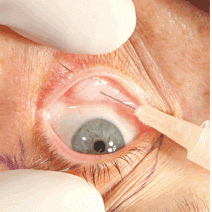
Transconjunctival Blepharoplasty
3. Some patients don’t have puffy under eye bags, they just have too much skin. For these individuals, I will do a pinch blepharoplasty which is just removal of extra skin. The scar sits just under your lower eyelashes and tends to disappear to nothing. Sutures are placed for this procedure and they either dissolve or are removed at 1 week.
4. I like to pair my lower eyelid surgeries with either a TCA peel or CO2 laser resurfacing to smooth out the crepey skin and erase fine lines and wrinkles. The CO2 laser has the added benefit of skin tightening by collagen stimulation.
5. Part of my exam during consultation looks at how elastic your lower eyelid is. If when I pull on your lower lid it is slow to snap back and cup the eye or if you always have a rim of red showing along your lower eye, you may need additional maneuvers to ensure that your eye is protected from ectropion or pulling down of the eyelid. Depending on the severity, I may refer you to an oculoplastic surgeon who specializes in complex eye issues.
Lower eyelid surgeries may be done under local (numbing medicine only), oral or IV sedation or general anesthesia depending on patient preference and safety. I generally place an eye shield during the procedure to protect your corneas and especially if I am planning to use the CO2 laser. Recovery is longer than an upper eyelid lift because the lower eyelid swells more and may bruise more. There is very little discomfort from the procedure but if you have a history of dry eyes, you may notice your eyes are more dry than usual for several weeks. By 2 weeks, most patients are out and about without anyone knowing they had surgery. Sometimes I have you do gentle massage after the first week to prevent scar from forming and pulling down on the eyelid.
The most common complications of lower eyelid surgery are ectropion (usually temporary) and/or over/under resection of the fat pads. Ectropion, as I mentioned above, is when the lower lid is pulled down and everted so that it no longer cups the eye and protects the cornea. This is usually most noticeable in the first few weeks and usually resolves as swelling goes down. Massage helps to break up this scar and keep the lower lid supple. Removing too little fat will leave puffiness behind. Removing too much fat will cause hollowing under the eye. Both of these may need revision but this is a discussion to be had between you and your surgeon.
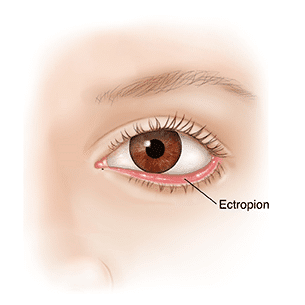
There is no age limit to when you may need a lower eyelid surgery. I have had patients in their 20’s and patients in their 80’s. Rarely does someone need a 2nd lower blepharoplasty because the fat, once removed, does not grow back. However, we do continue to age and small adjustments may be needed with filler and lasers to maintain your results.


